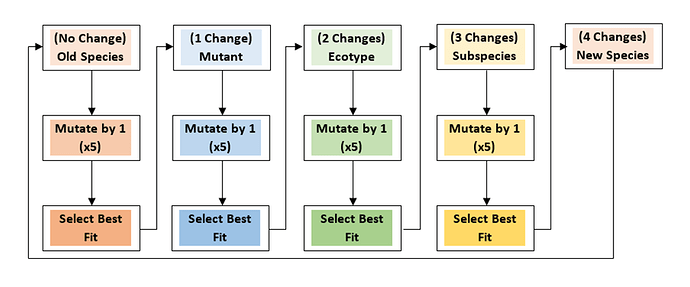I don’t know which category I should put this in, but this is an idea I had over a year ago. Keep in mind that this was made with the old Auto-Evo in mind, pre-Miche system, and before a lot of the new improvements and organelles were added.
Thrive Subspecies Random Generator Guidelines
- Generate and divide by 0.25: 0-0.25 Add, 0.25-0.5 Delete, 0.5-0.75 Change, and 0.75-1.0 Don’t Mutate;
- If Add, then generate and divide by 0.083,1/12: 0-0.083 Cytoplasm, 0.084-0.167 Metabolosome, 0.168-0.251 Thylakoids, 0.252-0.335 Chemosynthezing Proteins, 0.336-0.419 Rusticyanin, 0.420-0.503 Nitrogenase, 0.504-0.587 Oxytoxisome, 0.588-0.671 Thermosynthase, 0.672-0.755 Flagellum, 0.756-0.839 Pillus, 0.840-0.923 Chemoreceptor, and 0.924-1.0 Slime Jet; if Nucleus is included, divide by 0.077 and 0.923-1.0 Nucleus;
o 2a. Before adding, first count the number of sides starting from the center/top hex, then generate and divide by 1/side number;
o 2b. If orientation of hex is allowed, generate and divide by 0.166, 1/6; - If Delete, first count the number of hex starting from the center or top, and then generate and divide by 1/hex number to get the hex to delete;
- If Change, then repeat step 1, except: 0-0.333 Hex, 0.334-0.666 Membrane, and 0.667-1.0 Behavior;
o 4a. If Hex, then generate and divide by 0.5,1/2: 0-0.5 Change Position, 0.501-1.0 Substitute;
4a1. If Change Position, then repeat counting of hex as in step 2a to select hex and place it in a new position, and apply step 2b if applicable;
4a2. If Substitute, then repeat the same procedure in step 2a to select hex, but then repeat step 2, step 2a, and step 2b for substituted hex;
o 4b. If Membrane, then first generate and divide by 0.5,1/2: 0-0.5 Increase Membrane Fluidity, 0.501-1.0 Decrease Membrane Fluidity;
4b1. Generate and divide by 0.05,1/20 to find out how much to increase/decrease;
4b2. For membrane type, generate and divide by 0.166,1/6: 0-0.166 Single Membrane (Default), 0.167-0.332 Double Membrane, 0.333-0.498 Cellulose, 0.499-0.664 Chitin, 0.665-0.830 Calcium Carbonate, 0.831-1.0 Silica;
4b3. To change membrane color, randomly generate each R, G, and B number (R,G,B) and divide by 1/255;
o 4c. If Behavior, first generate and divide 0.5,1/2: 0-0.5 Increase Behavior, 0.501-1.0 Decrease Behavior;
4c1. Generate and divide by 1/64 to find out how much to increase/decrease;
4c2. Do this for all Behavior slides; - Repeat steps 1-4 as many times allowed per MP cost, but stop when no hex can be added, deleted, or substituted/moved from position;
- Repeat steps 1-6 four more times to generate other Subspecies, and take a screenshot of the edit screen for each Subspecies generated for further analysis;
o 6a. Should AI Speciation have occurred prior to generation of new Subspecies, then the number of Subspecies generated is 4 minus the number of AI Speciation Species; - Now, compare the Fitness Values of the Subspecies to the Fitness Value of the new Mutated Species;
o 7a. If only one Subspecies has a value higher Fitness Value than the Mutated Species, then replace the Mutated Species with the new Subspecies;
o 7b. If two or more Subspecies have a higher Fitness Value than the Mutated Species, then replace the Mutated Species with an probability average of all Subspecies with higher Fitness Values and determine the proportion of each Subspecies (i.e. Ssp1/Sum of Ssp1 and Ssp2);
7b1. To determine the proportional average hex included, overlap the shape based on the center hex;
• 7b1i. Multiply by the proportion of each Fit Subspecies to get hex total;
• 7b1ii. If more than one of the same hex is the same position, then place this hex type in the same position on the main Species;
• 7b1iii. If there are no hexes of the same type in the same position, then place the hex that gives the highest Fitness Value in the same position on the main Species;
• 7b1iv. Should MP be limiting, then only position/change the hexes that give the highest Fitness Value for the lowest MP from each Fit Subspecies;
7b2. To determine the average Membrane, first add the Membrane Fluidities of the Subspecies, and then divide by the number of Subspecies;
• 7b2i. For determining Membrane type, add the Membrane type that is common to two or more Subspecies;
• 7b2ii. If there are no Membranes of the same type, then place the Membrane that gives the highest Fitness Value on the main Species;
• 7b2iii. For determining the proportional average Membrane color, add the proportion of the RGB color value for each Subspecies;
7b3. To determine the average Behavior, first add the Behavior of the Subspecies, and then divide by the number of Subspecies for each Behavior slide; - Compare Fitness Values of new Species in current and nearby locations, if feasible;
o 8a. Pick the location with the highest Fitness Value for new Species;
o 8b. If two or more locations have the same Fitness Value, then generate and divide by the number of location;
Old Species → (1 hex) Mutant → (2 hexes) Ecotype → (3 hexes) Subspecies → (4 hexes) New Species
I welcome any suggestions or improvements.
